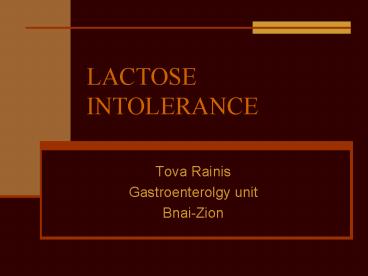LACTOSE INTOLERANCE - PowerPoint PPT Presentation
1 / 22
Title:
LACTOSE INTOLERANCE
Description:
Most common form of lactose malabsorption ... Molecular basis remains unknown. Developmental lactase deficiency ... Start with two Lactaid tablets with lactose ... – PowerPoint PPT presentation
Number of Views:4417
Avg rating:3.0/5.0
Title: LACTOSE INTOLERANCE
1
LACTOSE INTOLERANCE
- Tova Rainis
- Gastroenterolgy unit
- Bnai-Zion
2
- Common problem
- Europe and U.S.A 7-20 - Caucasians (lowest in
north Europe) , 80-95 Native American, 65-75
Africans and African Americans, 50 Hispanics - Eastern Asia, Jewish descent gt 90
3
Lactose intake
- Varies with age
- Infants 35-55 of daily calories ingested
- Lactose intake falls as weaning foods are
introduced - Average adult ingests 300 gram of carbohydrates
per day (52 starch, 37 sucrose, 5 lactose
(mainly in milk), 3 fructose)
4
Lactose digestion and colonic salvage of
nonabsorbed lactose
5
Etiology of lactose malabsorption
- Primary lactose malabsorption
- Racial or ethnic lactose malabsorption
- Developmental lactase deficiency
- Congenital lactase deficiency
- Secondary lactose malabsorption
- Bacterial overgrowth/stasis
- Mucosal injury of GIT that causes villus
flattening
6
Racial or ethnic lactose malabsorption
- Genetically determined reduction of lactase
activity - Most common form of lactose malabsorption
- The great majority of the worlds population
develop low intestinal lactase during
mid-childhood (approximately at age 5 yrs) - This finding is most prominent in Asian and
African populations rare in Caucasians of
Scandinavian background - Molecular basis remains unknown
7
Developmental lactase deficiency
- Low lactase levels as a consequence of
prematurity - Lactase activity in the fetus increases late in
gestation - Premature infants born at 28-32 weeks of
gestation have a reduced lactase activity
8
Congenital lactase deficiency
- Rare autosomal recessive disorder (Finnish
population) - Characterized by the absence of lactase activity
in the small intestine, with normal histologic
findings - A gene located on the same chromosome of the
lactase gene, is responsible for CLD - Affected infants have diarrhea from birth,
hypercalcemia and nephrocalcinosis
9
Secondary lactose malabsorption
- Bacterial overgrowth or stasis syndromes
- Increased fermentation of dietary lactose in the
small bowel, leading to symptoms of lactose
intolerance - Suspected from clinical history and from a very
early peak of breath hydrogen during lactose
challenge
10
Secondary lactose malabsorption - 2
- Mucosal injury
- Villus flattening or damage to the intestinal
epithelium - Celiac disease
- Crohns disease
- Radiation enteritis, chemotherapy
- HIV enteropathy
- Whipples disease
11
Secondary lactose malabsorption -3
- Lactase usually first affected disaccharidase in
these disorders, because of its distal location
on the villus - Treatment of the primary disorder can lead to
restoration of lactase activity - Restoration of lactase activity lags behind the
return of normal intestinal morphology
12
Clinical manifestations
- Abdominal pain crampy, localized to
periumbilical area, or lower quadrant - Bloating
- Flatulence
- Diarrhea
- Vomiting
- Stools are usually bulky, frothy and watery
13
Clinical manifestations - 2
- Meals with higher osmolality and fat content slow
gastric emptying and reduce the severity of
symptoms - Rapid intestinal motility ? rapid movement of
sugar are more symptomatic - Individuals have variable sensitivity to the
abdominal distention produced when undigested
lactose stimulates an influx of water into the
lumen or to gas production
14
Differential diagnosis
- Irritable bowel disease
- Inflammatory bowel disease
- Cystic fibrosis
- Diverticulitis
- Celiac sprue
- Acute gastroenteritis
- Giardiasis
15
Diagnosis
- Test absorption (lactose absorption test) or
malabsorption (lactose breath hydrogen test) - Lactose tolerance test
- Oral administration of 50 gram lactose
- Blood glucose levels 0, 60 and 120 min
- Increase of blood glucose by less than 20mg/dl
symptoms diagnostic - False negative diabetes, bacterial overgrowth,
delayed gastric emptying - Sensitivity of 75, specificity of 96
16
Diagnosis - 2
- Lactose breath hydrogen test
- Oral lactose (2g/kg)
- Breath hydrogen sampled at baseline and at 30 min
intervals for three hours - Breath hydrogen value of 10ppm normal, 10-20ppm
indeterminate unless symptomatic, gt20ppm
diagnostic - False positive recent smoking, false negative
recent use of antibiotics, lung disorders, 1
non-hydrogen producers
17
Diagnosis -3
- Under the age of 5 years abnormal test reflects
an abnormal intestinal mucosa or bacterial
overgrowth, both of which require further
evaluation by appropriate diagnostic tests - Normal breath hydrogen test psychologic
factors, intolerance to other factors in milk
18
Treatment
- In the absence of a correctable underlying
disease, the treatment includes four general
principles - Reduced dietary lactose intake
- Substitution of alternative nutrient sources to
maintain energy and protein intake - Administration of a commercially available enzyme
substitute - Maintenance of calcium intake
19
Dietary lactose restriction
- Highest concentration in milk and ice-cream, much
lower quantities in cheese - Complete restriction of lactose-containing foods
should be necessary for a limited period to
ascertain the specificity of the diagnosis - Since patients can tolerate graded increases in
lactose intake, small quantities of lactose may
subsequently be reintroduced into the diet, with
careful attention to development of symptoms
20
Enzyme replacement
- Commercially available lactase preparations
(bacterial or yeast beta galactosidases) - Lactaid, Lactrase, LactAce, DairyEase and Lactrol
- Start with two Lactaid tablets with lactose
ingestion, and adjust both the Lactaid dose and
the lactose load to tolerance
21
Calcium intake
- Avoidance of milk and other dairy products can
lead to reduced calcium intake, and increase in
risk of osteoporosis and fracture - Calcium carbonate
- Tums popular and effective
- Infants and young children liquid calcium
gluconate - Yogurt containing lactose is well tolerated by
the patients. The yogurt contains live cultures
of bacteria that produce lactase
22
- ???? ?? ??????

